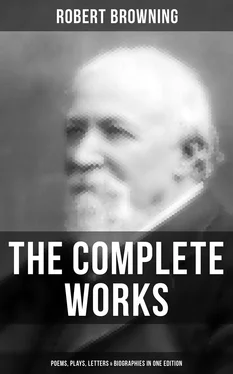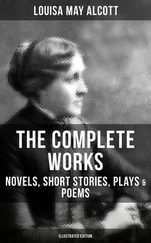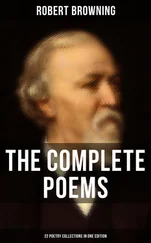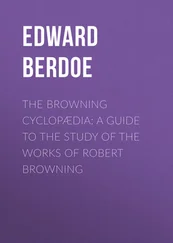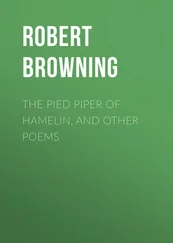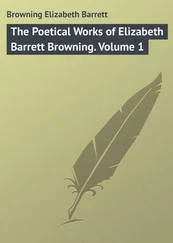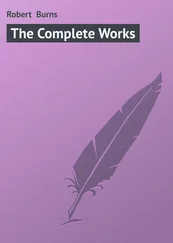His works rarely indicate this condition of feeling; it was not often apparent in his conversation. The faith which he had contingently accepted became absolute for him from all practical points of view; it became subject to all the conditions of his humanity. On the ground of abstract logic he was always ready to disavow it; the transcendental imagination and the acknowledged limits of human reason claimed the last word in its behalf. This philosophy of religion is distinctly suggested in the fifth parable of ‘Ferishtah’s Fancies’.
But even in defending what remains, from the most widely accepted point of view, the validity of Mr. Browning’s ‘message’, we concede the fact that it is most powerful when conveyed in its least explicit form; for then alone does it bear, with the full weight of his poetic utterance, on the minds to which it is addressed. His challenge to Faith and Hope imposes itself far less through any intellectual plea which he can advance in its support, than through the unconscious testimony of all creative genius to the marvel of conscious life; through the passionate affirmation of his poetic and human nature, not only of the goodness and the beauty of that life, but of its reality and its persistence.
We are told by Mr. Sharp that a new star appeared in Orion on the night on which Robert Browning died. The alleged fact is disproved by the statement of the Astronomer Royal, to whom it has been submitted; but it would have been a beautiful symbol of translation, such as affectionate fancy might gladly cherish if it were true. It is indeed true that on that twelfth of December, a vivid centre of light and warmth was extinguished upon our earth. The clouded brightness of many lives bears witness to the poet spirit which has departed, the glowing human presence which has passed away. We mourn the poet whom we have lost far less than we regret the man: for he had done his appointed work; and that work remains to us. But the two beings were in truth inseparable. The man is always present in the poet; the poet was dominant in the man. This fact can never be absent from our loving remembrance of him. No just estimate of his life and character will fail to give it weight.
The Brownings: Their Life and Art
Table of Contents
Foreword
Illustrations
Chapter I
Chapter II
Chapter III
Chapter IV
Chapter V
Chapter VI
Chapter VII
Chapter VIII
Chapter IX
Chapter X
Chapter XI
Chapter XII
Index
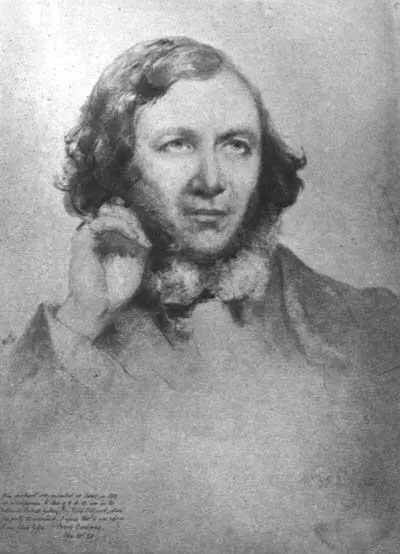
ROBERT BROWNING
From a drawing made by Field Talfourd, in Rome, 1855
Table of Contents
The present volume was initiated in Florence, and, from its first inception, invested with the cordial assent and the sympathetic encouragement of Robert Barrett Browning. One never-to-be-forgotten day, all ethereal light and loveliness, has left its picture in memory, when, in company with Mr. Browning and his life-long friend, the Marchesa Peruzzi di’ Medici ( náta Story), the writer of this biography strolled with them under the host’s orange trees and among the riotous roses of his Florentine villa, “La Torre All’ Antella,” listening to their sparkling conversation, replete with fascinating reminiscences. To Mr. Browning the tribute of thanks, whose full scope is known to the Recording Angel alone, is here offered; and there is the blending of both privilege and duty in grateful acknowledgements to Messrs. Smith, Elder, & Company for their courtesy in permitting the somewhat liberal drawing on their published Letters of both the Brownings, on which reliance had to be based in any effort to
“Call up the buried Past again,”
and construct the story, from season to season, so far as might be, of that wonderful interlude of the wedded life of the poets.
Yet any formality of thanks to this house is almost lost sight of in the rush of memories of that long and mutually-trusting friendship between the late George Murray Smith, the former head of this firm, and Robert Browning, a friendship which was one of the choicest treasures in both their lives.
To The Macmillan Company, the publishers for both the first and the present Lord Tennyson; To Houghton Mifflin Company; to Messrs. Dodd, Mead, & Company; to The Cornhill Magazine (to which the writer is indebted for some data regarding Browning and Professor Masson); to each and all, acknowledgments are offered for their courtesy which has invested with added charm a work than which none was ever more completely a labor of love.
To Edith, Contessa Rucellai ( náta Bronson), whose characteristically lovely kindness placed at the disposal of this volume a number of letters written by Robert Browning to her mother, Mrs. Arthur Bronson, special gratitude is offered.
“Poetry,” said Mrs. Browning, “is its own exceeding great reward.” Any effort, however remote its results from the ideal that haunted the writer, to interpret the lives of such transcendent genius and nobleness as those of Robert and Elizabeth Barrett Browning, must also be its own exceeding reward in leading to a passion of pursuit of all that is highest and holiest in the life that now is, and in that which is to come.
LILIAN WHITING
The Brunswick, Boston
Midsummer Days, 1911
Table of Contents
| In Photogravure |
| Robert Browning From a drawing by Field Talfourd, Rome, 1855 |
Frontispiece |
|
Page |
| Elizabeth Barrett Browning From a drawing by Field Talfourd, Rome, 1855 |
39 |
|
| Engravings |
| Busts of Robert and Elizabeth Barrett Browning |
2 |
| Monument to Michael Angelo, by Vasari Church of Santa Croce, Florence |
80 |
| Old Monastery at Vallombrosa |
98 |
| The Guardian Angel, Guercino Church of San Agostino, Fano |
103 |
| Monument to Dante, by Stefano Ricci Piazza di Santa Croce, Florence |
108 |
| Palazzo Vecchio, Florence |
113 |
| Statue of Savonarola, by E. Pazzi Sala dei Cinquecento, Palazzo Vecchio, Florence |
116 |
| Fresco of Dante, by Giotto The Bargello, Florence |
121 |
| Cathedral of Santa Maria del Fiore, Florence (known as the Duomo) |
126 |
| The Ponte Vecchio and the Arno, Florence |
142 |
| Casa Guidi |
146 |
| The Clasped Hands of the Brownings Cast in bronze from the model taken by Harriet Hosmer in Rome, 1853 |
153 |
| The Campagna and Ruins of the Claudian Aqueducts, Rome |
156 |
| The Coronation of the Virgin, by Filippo Lippi Accademia di Belle Arti, Florence |
166 |
| Andrea del Sarto. Portrait of the Artist and his Wife Pitti Gallery, Florence |
170 |
| Equestrian Statue of Ferdinando de’ Medici, by Giovanni da Bologna Piazza dell’ Annunziata, Florence |
174 |
| Villa Petraja, near Florence |
178 |
| Church of San Miniato, near Florence |
182 |
| The Palazzo Barberini, Via Quattro Fontane, Rome |
188 |
| The English Cemetery, Florence |
197 |
| Tomb of Elizabeth Barrett Browning |
200 |
| Kate Field From the portrait by Elihu Vedder, Florence, 1860 |
208 |
| The Pallazzo Riccardi, Florence |
214 |
| Bust of Robert Browning, by his Son |
226 |
| Portrait of Robert Browning in 1882, by his Son |
242 |
| Church of San Lorenzo, Florence |
246 |
| Portrait of Robert Barrett Browning, as a Child, 1859 |
263 |
| Portrait of Robert Browning, by George Frederick Watts, R.A. |
270 |
| Mrs. Arthur Bronson, by Ellen Montalba, in Asolo |
274 |
| Miss Edith Bronson, (Comtessa Rucellai) |
280 |
| Portrait of Professor Hiram Corson, by J. Colin Forbes, R.A. |
290 |
| Palazzo Rezzonico, Venice |
294 |
| Engraved Facsimile of a letter from Robert Browning to Professor Hiram Corson |
260 |
Читать дальше
